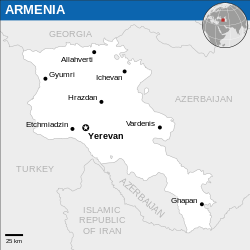Armenia
Coordinates: 40°N 45°E / 40°N 45°E Armenia i tiko ra Axiya.
| Republic of Armenia Հայաստանի Հանրապետություն Hayastani Hanrapetut’yun (Armenian) | |
|---|---|
 | |
 | |
| Ntsindza-doroba |
Yerevan 40°11′N 44°31′E / 40.183°N 44.517°E |
| Tindzimi-Ximfumo | Armenian[1] |
| Ethnic groups (2011) | |
| Religion | Armenian Apostolic Church[4] |
| Demonym | Armenian |
| Government | Unitary parliamentary republic |
| Armen Sarkissian | |
| Nikol Pashinyan | |
| Ara Babloyan | |
| Legislature | National Assembly |
| Formation and independence | |
• Traditional date | 2492 BC |
| 1500–1290 BC | |
| 14th century–1190 BC | |
| 860–590 BC | |
| 6th century BC | |
• Kingdom of Greater Armenia united under the Artaxiad Dynasty[8] | 190 BC[9] |
| 52–428 | |
| 885–1045 | |
| 1198–1375 | |
|
28 May 1918 | |
• Independence from the Soviet Union | 21 September 1991 |
| Area | |
• Total | 29,743 km2 (11,484 sq mi) (138th) |
• Water (%) | 4.71[10] |
| Population | |
• 2016 estimate | 2,924,816[11] |
• 2011 census |
|
• Density | 101.5/km2 (262.9/sq mi) (99th) |
| GDP (PPP) | 2017 estimate |
• Total | $28,282 billion[14] |
• Per capita |
$9,456[14] |
| GDP (nominal) | 2017 estimate |
• Total | $11,548 billion[14] |
• Per capita | $3,861[14] |
| Gini (2013) |
31.5[15] medium |
| HDI (2015) |
high · 84th |
| Currency | Dram (֏) (AMD) |
| Time zone | AMT (UTC+4) |
| Drives on the | right |
| Calling code | +374 |
| Patron saint | St. Gregory |
| ISO 3166 code | AM |
| Internet TLD | |
- Armenia
-
Yerevan
-
Garni
-
Vagharshapat
-
Khor Virap
-
Sevanavank
-
Khatchkar
Mintsaho[Lulamisa | edit source]
- ↑ "Constitution of Armenia, Article 20". president.am.
- ↑ Asatryan, Garnik; Arakelova, Victoria (Yerevan 2002). The Ethnic Minorities in Armenia. Part of the OSCE. at WebCite (16 April 2010).
- ↑ Ministry of Culture of Armenia "The ethnic minorities in Armenia. Brief information" Archived 2017-10-10 at the Wayback Machine.. As per the most recent census in 2011. "National minority".
- ↑ "National Assembly of the Republic of Armenia - Official Web Site - parliament.am". www.parliament.am.
- ↑ Lang, David Marshall. Armenia: Cradle of Civilization. London: Allen and Unwin, 1970, p. 114. ISBN 0-04-956007-7.
- ↑ Redgate, Anna Elizabeth. The Armenians. Cornwall: Blackwell, 1998, pp. 16–19, 23, 25, 26 (map), 30–32, 38, 43 ISBN 0-631-22037-2.
- ↑ Redgate, A. E. (2000). The Armenians (Reprint ed.). Oxford: Blackwell. p. 5. ISBN 0-631-22037-2. "However, the most easily identifiable ancestors of the later Armenian nation are the Urartians."
- ↑ de Laet, Sigfried J.; Herrmann, Joachim, eds. (1996). History of Humanity: From the seventh century B.C. to the seventh century A.D. (1st ed.). London: Routledge. p. 128. ISBN 978-92-3-102812-0. "The ruler of the part known as Greater Armenia, Artaxias (Artashes), the founder of a new dynasty, managed to unite the country..."
- ↑ Encyclopedia Americana: Ankara to Azusa. Scholastic Library Publishing. 2005. p. 393. "It was named for Artaxias, a general of Antiochus the Great, who founded the kingdom of Armenia about 190 B.C."
- ↑ "The World Fact Book – Armenia". Central Intelligence Agency. Archived from the original on 19 July 2010. Retrieved 17 July 2010. Unknown parameter
|df=ignored (help) - ↑ "World Population Prospects: The 2017 Revision". ESA.UN.org (custom data acquired via website). United Nations Department of Economic and Social Affairs, Population Division. Retrieved 10 September 2017.
- ↑ "Statistical Service of Armenia". Armstat. Retrieved 20 February 2014.
- ↑ "Armenia Population". countrymeters.info.
- ↑ 14.0 14.1 14.2 14.3 "Report for Selected Countries and Subjects". World Economic Outlook Database, April 2018. Washington, D.C.: International Monetary Fund. 4 October 2017. Retrieved 17 January 2018.
- ↑ "Gini index". World Bank. Retrieved 12 May 2016.
- ↑ "Human Development Report 2016". United Nations. 2016. Retrieved 28 September 2017.









